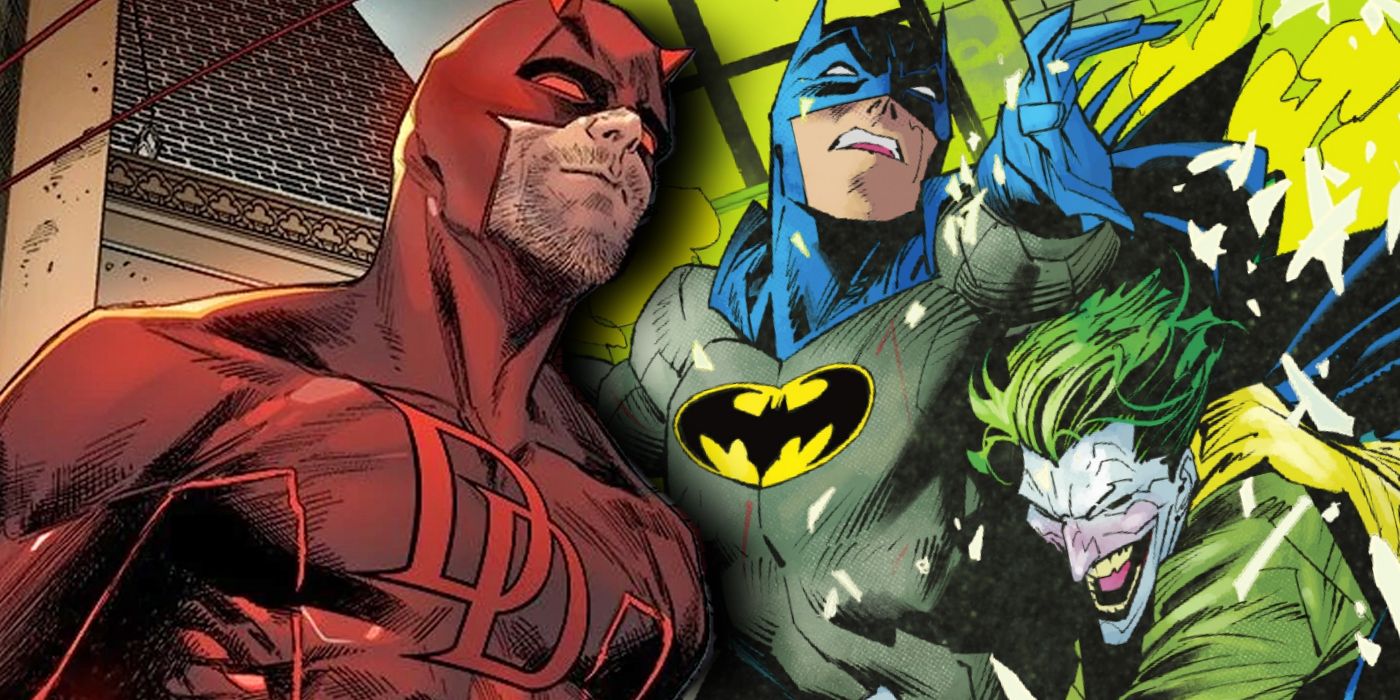Warning: The following contains spoilers for Detective Comics #1040, on sale now from DC.
Although they do have a few key differences, Marvel’s Daredevil and DC’s Batman have many obvious similarities. Above all, both vigilantes are dedicated to helping their respective cities and ensuring justice is served.
In Detective Comics #1040, by Mariko Tamaki, Dan Mora, Jordie Bellaire and Aditya Bidikar, Batman just showed another recent similarity to Daredevil by turning himself in to the police.
Bruce Wayne had previously been held in custody by the GCPD, during an investigation around the murders of Sarah Worth and Lydia Warren. When the precinct was attacked by Sarah’s father, Mister Worth, Bruce had an easy chance to escape custody. Yet Bruce chose to turn himself back in, a move similar to Matt Murdock’s recent actions in the pages of Daredevil.
At the end of Daredevil #20, by Chip Zdarsky, Marco Checchetto, Mattia Iacono and VC’s Clayton Cowles, The Man Without Fear turned himself in to the police for killing a criminal named Leo Carraro. Eventually, Matt went to prison as Daredevil. Just like Bruce, Daredevil also had the opportunity to escape custody.
Elektra tried to break Matt out of prison to help her fight the Hand, and Knull’s attack during “King in Black” was also a prime opportunity to escape prison. Despite these opportunities to escape, Daredevil stayed put. Of course, Batman and Daredevil had completely different reasons for turning themselves in.
Bruce only turned himself in to bide his time, while Oracle helped the police figure out Bruce’s innocence. In this way, The Dark Knight was trying to get himself cleared as quickly as possible so that the GCPD wasn’t simultaneously hunting Bruce Wayne and Batman.
Daredevil’s story, however, was quite different. For one thing, Matt turned himself in as Daredevil, rather than Matt Murdock. Additionally, Daredevil actually committed his crime, unlike Bruce, who was merely a suspect in his case. Even though the circumstances are different for the two heroes, these scenarios speak to the similar morals of Batman and Daredevil.
Both are devoted to justice no matter what. In Daredevil’s case, this means serving his time for his crimes. Batman, on the other hand, is determined to clear his own name so he can go after the real murderer in Gotham.
As much as Daredevil is devoted to justice, however, he also has a major guilt complex that drives his morals. Even though Matt’s friends and allies were determined to fight the charges against him, Daredevil himself decided to serve time in jail so he could atone for his sins. Many argued that Daredevil was needed out on the streets of Hell’s Kitchen, yet Matt has decided to stay in prison, both to serve justice and make peace with his own guilt.
It also helped that Elektra was there to take care of Hell’s Kitchen in Matt’s absence. Batman doesn’t share Daredevil’s same sense of guilt, as he’s more compulsively fixated on crime-fighting. The main reason that Bruce turned himself in to the police was so he could clear his name and get back on the streets. This is pretty similar to the classic “Bruce Wayne: Murderer” and “Bruce Wayne: Fugitive” storylines.
Just like in Detective Comics #1040, Bruce was accused of a crime he didn’t commit. While Bruce did go to jail for a while, he eventually broke out in 2002’s Birds of Prey #40, by Chuck Dixon, Rick Leonardi, Jesse Delperdang, Wildstorm FX and Albert T. De Guzman, to find the real culprit. Of course, if Batman did commit a crime, like Daredevil, circumstances might be different. Still, it’s hard to imagine Batman staying off the streets, considering his devotion to crime-fighting.
Luckily, Batman does have his Bat-Family, just as Daredevil has Elektra, to take up their respective crusades. Yet there is very little that would keep Batman off the streets for very long, even if his allies were there to help. The Dark Knight is simply too attached to his crusade, while The Man Without Fear is devoted to repenting for his sins.
About The Author

